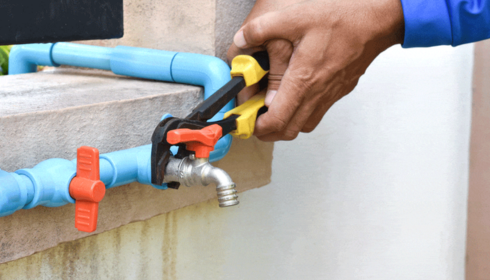There’s something oddly peaceful about the quiet hum of a well-functioning home. The pipes are working, the water flows where it should, and everything just… runs. But the moment something goes wrong — the drip behind the wall, the unexplained spike in your water bill, or that faint hiss from the yard — that peace shatters. Suddenly, you’re reminded that what’s beneath your feet and behind your walls matters a lot more than you realize.
We often take plumbing and underground lines for granted. They’re invisible until they’re not — until a leak or a crack pulls them into our attention. And when that happens, getting the right professionals with the right tools isn’t just smart; it’s essential.
The Subtle Art of Finding What You Can’t See
There’s a kind of quiet heroism in modern leak detection. It’s not glamorous, but it’s impressive — like finding a whisper in a hurricane. Gone are the days when plumbers had to tear up half your yard or smash through drywall just to figure out where water was escaping. Now, technology does the heavy lifting.
Specialized equipment — thermal cameras, ultrasonic sensors, acoustic devices — can pinpoint even the tiniest leaks, often within inches of accuracy. These tools “listen” to changes in sound or temperature, tracing problems hidden behind concrete, soil, or tile. It’s an elegant solution to what used to be a destructive guessing game.
But it’s not just about saving property; it’s about saving time, money, and sanity. Water leaks don’t just waste resources — they can damage foundations, invite mold, and weaken structures. Early detection is like catching a cold before it turns into pneumonia.
And the best part? When done right, leak detection doesn’t disturb your home at all. It’s quiet, precise, and oddly futuristic — plumbing’s answer to detective work.
When It’s More Than Just a Leak
Finding a problem is one thing. Fixing it is another story entirely. Once you know where the issue lies, the real work begins: repairing the line that keeps your home connected.
Line repair can mean many things — from sealing a minor crack in a pipe to replacing large sections of corroded or broken lines underground. The challenge lies in doing it efficiently, without turning your yard into a construction zone.
This is where trenchless repair technology comes in. Instead of digging up the entire length of a pipe, specialists can create small access points at each end and pull a new pipe through the old one, sealing cracks and restoring flow without disruption. It’s faster, cleaner, and usually more affordable than traditional methods.
And let’s be honest — nobody wants to see their beautiful lawn or newly paved driveway ripped apart for repairs. The fact that modern plumbing tech allows for precision fixes is one of those small miracles of engineering that most of us will never fully appreciate — until we need it.
Installing the Lifelines of a Home
If repair is about restoration, then line installation is about creation. It’s laying the groundwork — literally — for everything that makes a home functional and livable.
Installing new water or gas lines requires an incredible mix of precision and foresight. It’s not as simple as connecting point A to point B. The angles, pressure levels, material choice, and even soil composition all play a role. A miscalculation during installation can lead to leaks years down the road or inefficiencies that waste energy and water.
That’s why reputable plumbers treat installation as both science and art. They plan, map, test, and double-check before a single trench is dug. It’s one of those jobs where the best compliment is invisibility — when the system runs so smoothly you forget it’s even there.
Good installation work is like a strong foundation. You don’t see it, but everything depends on it.
Why Small Problems Become Big Ones
The tricky thing about plumbing issues is that they rarely announce themselves with fanfare. A tiny leak, a faint smell of gas, a small dip in water pressure — these are the first signs, the whispers before the storm. Left alone, they grow silently until one day, you’re dealing with a flooded basement or a massive utility bill.
The problem isn’t just the damage itself — it’s the chain reaction. Moisture can seep into walls, rust metal components, and even compromise your home’s electrical system. Gas leaks, meanwhile, can be downright dangerous.
Catching these issues early is what separates a small fix from a financial nightmare. That’s why professional inspections and routine maintenance are worth their weight in gold.
The Technology That’s Changing the Game
It’s kind of amazing how much plumbing has evolved in the last two decades. We’ve gone from shovels and hammers to cameras, sensors, and even robots. In some advanced systems, technicians can send small cameras through lines to inspect blockages or corrosion, like a surgeon using a tiny scope.
Smart water meters now track usage in real time, alerting homeowners to possible leaks before they become visible. And materials themselves have improved — modern PEX piping, for example, resists corrosion and adapts better to temperature changes than older copper or steel lines.
It’s all part of a broader shift: using data and innovation to make homes safer, more efficient, and less disruptive to maintain. Plumbing isn’t just about wrenches anymore; it’s about precision engineering and predictive maintenance.
When Experience Still Matters
For all the technology in the world, one thing hasn’t changed — experience still counts. The best plumbers know how to listen, not just to the machines, but to the signs a home gives off. A faint vibration in a pipe, a certain sound when water runs, a subtle pressure fluctuation — these details speak volumes to a trained ear.
Technology helps, but it can’t replace intuition. It’s that balance — experience backed by innovation — that defines the best plumbing work today. The kind that doesn’t just fix a problem but prevents the next one before it starts.
The Hidden Value of Prevention
Here’s the truth most homeowners learn the hard way: prevention is cheaper than repair. Regular inspections, maintenance, and system updates might seem like an expense, but they’re really an investment.
A leak caught early saves thousands in water damage. A weakened gas line replaced before it fails prevents disasters. An aging pipe upgraded today spares you the nightmare of emergency repairs tomorrow.
It’s the difference between being proactive and reactive — and when it comes to plumbing, that difference can be everything.
The Calm After the Chaos
There’s something oddly comforting about the quiet after a plumbing issue is resolved. The hum returns. The water flows. The house breathes again.
It’s easy to forget how much life depends on what we don’t see — the lines, the connections, the delicate balance of pressure and flow that keeps everything working. But that’s the beauty of it, too. When done right, plumbing is invisible. Effortless. Reliable.

